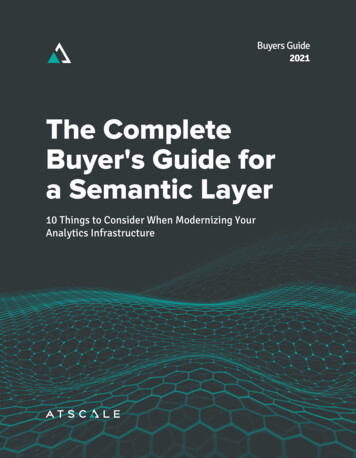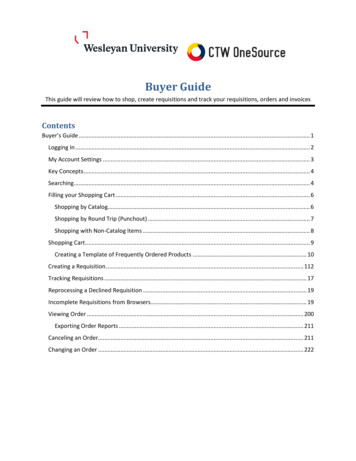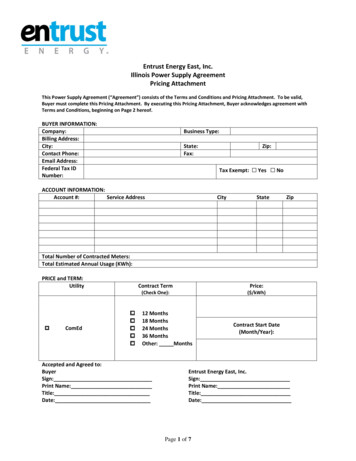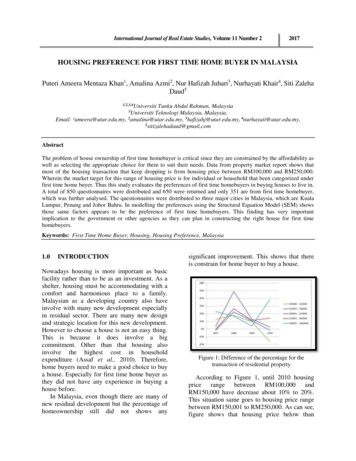
Transcription
Buyers Guide2021The CompleteBuyer's Guide fora Semantic Layer10 Things to Consider When Modernizing YourAnalytics Infrastructure
Unprecedented levels of data scaleand distribution are making it almostimpossible for organizations toeffectively exploit their data assets.Data and analytics leaders mustadopt a semantic approach to theirenterprise data assets or face losingthe battle for competitive advantage.GARTNER“How to Use Semantics to Drive the Business Value of Your Data”27 November 2018
ABOUT THIS GUIDESemantic layers have been around for some time. They were invented as a way to mold relationaldatabases and their SQL dialects into an approachable Interface for business users. In 1992, BusinessObjects patented the term and formalized their implementation as the Business Objects UniverseTM.From that point forward, the concept of measure and dimensions as an abstraction of SQL hasbecome the preferred language for business users.Until recently, however, the semantic layer was always tightly coupled to the business intelligence(BI) platform. As a result, tools like Business Objects had their unique semantic layer, separate anddistinct from Cognos’ semantic layer, MicroStrategy’s semantic layer, Tableau’s semantic layer and soforth. As long as enterprises stayed within the walled garden of the BI platform vendor of choice, allwas good. Today, there are a variety of ways of analyzing data and long gone are the days where therewas one BI platform to rule them. Tightly coupling a semantic layer to one analytics consumptionstyle just no longer makes sense.To expand on that, the explosion of self-service BI has created some unintended consequences. Whilebusiness users freed themselves from the chains of IT-prepared analytics, data consistency and trustin analytics’ output took a huge hit. Business definitions and terms have become mutable, malleable,and subject to interpretation. It’s great that business users have more tools to perform BI themselves,but they need to be working off of consistent, high-quality data because the cost of bad data isenormous. According to IBM, poor data quality costs the US economy around 3.1 trillion annually.It’s time for a new approach to driving trust in the numbers that better fits better with today’s datavolume, velocity and variety. In this guide, we will look at the different approaches to selecting andimplementing a semantic layer for your analytics stack that will drive consistency, ease of use andtrust for a wide variety of analytics consumption types and use cases.
TABLE OF CONTENTSWhat Is a Semantic Layer? 1The Top 5 Signs You Need to Invest in a Semantic Layer 2Business Units or Groups Have Strong Preferences for Different Analytics Tools 2Business Analysts and/or Data Scientists Complain About a Lack of Data Access 3The Slow Pace of Data Integration Drives the Business to Build their Own Solutions 3Reports from Different BI Tools Use Similar Terms but Show Different Results 4Business Executives Express Doubts About Their Confidence in the Numbers 4Getting Started On Your Search 5Key Considerations 6Not Tied to a Single Consumption Style 6Offers Tabular and Multidimensional Views 7Supports Data Platform Virtualization 7Easy Model Development and Sharing 8Ability to Express Business Concepts and Functions 8Query Performance & Caching 8Support for Business Intelligence and Data Science Workloads 9Security & Governance 9Feature Checklists 11Conclusion 12Resources & Further Reading 13
WHAT IS SEMANTIC LAYER?In defining a semantic layer, I still haven’t found a better definition than that of Wikipedia’s:“A semantic layer is a business representation of corporate data that helps end users access dataautonomously using common business terms. A semantic layer maps complex data into familiarbusiness terms such as product, customer, or revenue to offer a unified, consolidated view of dataacross the organization.By using common business terms, rather than data language, to access, manipulate, and organizeinformation, a semantic layer simplifies the complexity of business data. Business terms are stored asobjects in a semantic layer, which are accessed through business views.The semantic layer enables business users to have a common "look and feel" when accessing andanalyzing data stored in relational databases and OLAP cubes. This is claimed to be core businessintelligence (BI) technology that frees users from IT while ensuring correct results.Business Views is a multi-tier system that is designed to enable companies to build comprehensiveand specific business objects that help report designers and end users access the information theyrequire. Business Views is intended to enable people to add the necessary business context to theirdata islands and link them into a single organized Business View for their organization.”Source: Wikipedia (https://en.wikipedia.org/wiki/Semantic layer) 2020 AtScale Inc. All rights reserved.1
THE TOP 5 SIGNS YOU NEED TO INVESTIN A SEMANTIC LAYERWhile working with a variety of customers in a number of different industries, we found that theyshared a common set of symptoms resulting from the ailment of a missing semantic layer. If thefollowing situations sound familiar, you should keep reading.1. BUSINESS UNITS OR GROUPS HAVE STRONG PREFERENCES FORDIFFERENT ANALYTICS TOOLSThe larger the organization, the tougher it becomes to impose a single standard for consuming andpreparing analytics. Whether through acquisitions or just the strong will of business users, forcing asingle tool or analytics style is a futile endeavor. The large enterprises we work with are dealing withdozens of BI tools, all with their own versions of the truth. According to the Dresner’s Wisdom ofCrowds Business Intelligence Study, over half of enterprises report using three or more BI tools,with over a third using four or more.On top of that, the advent of the data scientist as yet another analytics consumer creates an evenmore dire situation. Now, not only do business analysts risk creating bad reports, data scientists riskcreating misleading predictions - both have profound implications for business results.To make matters worse, the pace of innovation in cloud data warehousing, BI and AI/ML has createda constant cycle of upgrades, re-platforms and re-factors.If you find yourself at the losing end of dictating analytics tools and consumption styles in yourorganization, don’t fret. By providing “analytics-as-a-service” to your business users and datascientists, you can have your cake and eat it too: let your users consume the way that makes sense fortheir use case while ensuring semantic consistency and data governance. 2020 AtScale Inc. All rights reserved.2
2. BUSINESS ANALYSTS AND/OR DATA SCIENTISTS COMPLAIN ABOUT ALACK OF DATA ACCESSThere’s rarely a lack of data in an enterprise but there’s often a lack of understandable data. Datawithout metadata is practically useless. Whether it’s data in log files or data in relational tables,without a business context, it’s left to the analyst or data scientist for interpretation. In other words,data without business intelligence is useless and can be even dangerous. This is not an uncommonphenomenon. According to Gartner, 87 percent of organizations have low BI and analytics maturity.If you hear your analytics consumers complaining that they lack data to make decisions, yourorganization may be suffering from data without metadata. Without a semantic layer powered by adata model, your organization may be slow to respond to changing market conditions. Businessanalysts and data scientists need a business context to turn raw data into actionable insights.3. THE SLOW PACE OF DATA INTEGRATION DRIVES THE BUSINESS TOBUILD THEIR OWN SOLUTIONSGiven the fast pace of today’s business climate, waiting for a centralized data group to producereports and dashboards for business users is a thing of the past. According to a recent MIT study,companies in the top three spots in their industry that rely on data-driven decision making were, onaverage, 5% more productive and 6% profitable than their competitors. This incentive to leveragedata to compete drove the self-service BI revolution where business users took reporting and dataengineering into their own hands.While business users got their data faster, the unintended consequences of this decentralizedapproach are obvious. Numerous data platforms, a proliferation of data marts and a large variety of BItools is a good indicator of the dark side of DIY analytics and proof that your organization may need asemantic layer. 2020 AtScale Inc. All rights reserved.3
4. REPORTS FROM DIFFERENT BI TOOLS USE SIMILAR TERMS BUT SHOWDIFFERENT RESULTSIf multiple business units or groups are preparing their own reports and dashboards without acommon semantic layer, chances are high that different tools will produce different results. Most BItools include their own modeling layer and all support custom calculations. Whether an error in tablerelationships or joins, inconsistent use of the company calendar for time based calculations or justmistakes in formulas, you are almost guaranteed to have different numbers for the same data.If you find inconsistencies in financial reporting from different spreadsheets and reports, yourorganization is likely suffering from a lack of a common semantic layer. See the next section for thepotential consequences.5. BUSINESS EXECUTIVES EXPRESS DOUBTS ABOUT THEIR CONFIDENCE INTHE NUMBERSAccording to Forrester Research’s B2B Data Activation Priority report, less than half of firms believethey execute very well in having customer data they fully trust. Once business executives lackconfidence in the numbers, every decision is subject to delay. Trust in the data is a major competitivedifferentiating factor for the best businesses. According to Experian, six in ten companies believe thathigh-quality data increases efficiency in their business, with a sizable percentage believing that it notonly increases customer trust (44%) and enhances customer satisfaction (43%) but also enablesmore informed decision making (42%) and cuts costs (41%).If you find your business sponsors performing their own on-the-fly report reconciliation, you may besuffering a crisis in confidence. Self-service analytics without the foundation of a common semanticlayer and data governance makes it difficult to build trust and prove data quality.You don’t need to sacrifice data self service to create trust, though. A universal semantic layer canpower data self service while ensuring the consistency, fidelity and explainability of analytic outputs. 2020 AtScale Inc. All rights reserved.4
GETTING STARTED ON YOUR SEARCHThere are several technical approaches to implementing a semantic layer in your organization. Thetable below lists each approach’s pros and cePlatformsTraditional BIplatforms thatbundle datamodeling, querymanagement ms thatabstract away thephysical source andlocation of data in atabular format Provides flexibility Not friendly forin how/where datais stored Semantic layer canbe used across avariety of toolsbusiness users(tables, columns) Data models needto be built beforeaccessing data Query performanceis not guaranteedand/or needsmanual tuningDataWarehouse/DataMartsA database ofinformation from avariety of datasources Single source of Not friendly fortruth Widest array oftool/query access Easy to securebusiness users(tables, columns) Slow to integratenew data sources Dependence on ITBusinessSemantic LayersA platform thatpresents abusiness data viewthat helps usersaccess dataautonomouslyusing commonbusiness terms Business user Extra technologyfriendly Single source oftruth Provides flexibilityin how/where datais stored Semantic layer canbe used across avariety of tools Easy to securelayer required Data models needto be built beforeaccessing data No extra Semantic layertechnology layerneeded Tight integration Business userfriendlyspecific to BI toolonly (not reusable) Vendor lock inEXAMPLE VENDORSTableauPower BIIBM CognosSAP Business ObjectsLookerDenodo DremioSnowflakeAmazon RedshiftGoogle BigQueryAzure Synapse SQLAnalyticsAtScaleSQL Server AnalysisServicesIllustration 1: Approaches for implementing a semantic layer 2020 AtScale Inc. All rights reserved.5
As you can see above, a business-oriented semantic layer provides the best tradeoffs given its blendof data virtualization technology and the benefits of traditional BI platforms’ semantic and modelingcapabilities without the vendor lock in that comes with these tools.Recommendation: A business oriented semantic layer promotes safe and secure,self service analytics consumption while driving consistency and reducing costs.KEY CONSIDERATIONSWhen choosing a vendor, there are a few core capabilities to keep in mind. Depending on your needs,you can weigh the options accordingly. The following categories are further broken down in ourchecklist later in this document.Not Tied to a Single Consumption StyleFrom the beginning, the BI platform was synonymous with the term “semantic layer”. In recent years,however, the monolithic BI platform has given way to more component-based architectures. Asanalytics have become more widespread in an organization, relying on a single BI platform to beeverything to everyone just isn’t realistic. That means that any semantic layer tied to a specific BI toolor platform cannot be a “universal” semantic layer - it’s a semantic layer for that tool. In a landscapeof many tools and analytics personas, it’s essential that your semantic layer be decoupled from asingle consumption style. It needs to be truly “universal”.Recommendation: When choosing a vendor, make sure that the vendor’s semanticlayer works across a variety of BI and AI/ML consumers - not just their ownvisualizations layer. 2020 AtScale Inc. All rights reserved.6
Offers Tabular and Multidimensional ViewsThere are two types of semantic layers, or models, to consider: a tabular semantic layer and amultidimensional semantic layer.The tabular or relational model was popularized by modeling gurus like EF Codd and Ralph Kimbal inthe 70s and 80s. These modeling techniques rely on concepts like fact and dimension tables and aremeant to make a relational database or data warehouse easier to query. The multidimensional datamodel goes one step further. By defining relationships and aggregation rules, the multidimensionalsemantic model adds a business friendly context and makes hand writing SQL either unnecessary orsubstantially more simplistic. For the widest range of uses and consumption styles, amultidimensional semantic layer offers more power in an easier to use package.Recommendation: Choose a semantic layer that offers both tabular andmultidimensional views to cover the widest range of use casesSupports Data Platform VirtualizationIt seems like just about every five years we see a new data platform style or trend become all therage. First, it was the mainframe. Then, the relational database, the data warehouse, the MPPdatabase, the data lake and now back to the data warehouse (but in the cloud). If your organizationhas been around long enough, you probably have one of everything. As technology trends shortenand we see a wider range of options for data platforms and storage, it’s essential that your semanticlayer future proofs your data platform choice. Data virtualization is an excellent hedge against futureplatform change and minimizes or eliminates the cost of migrating to those new data platforms. Agood semantic layer should offer data virtualization as its core mechanism for querying the underlyingdata and thereby hide the physical implementation of the data platform to prevent vendor lock in.Recommendation: Choose a vendor that leverages data virtualization to abstractaway data platform differences and minimized platform lock in. 2020 AtScale Inc. All rights reserved.7
Easy Model Development and SharingRaw data is just data. By adding a data model to raw data, we turn that data into consumableinformation. It’s imperative that the platform you choose makes authoring, sharing and collaboratingon data models as simply as possible. Choose a semantic layer platform that supports collaborativemodel development, re-use of common objects and conformed dimensions and the ability to visuallymodel data in addition to opting for a code based approach that’s compatible with your organization'ssoftware development life cycle (SDLC).Recommendation: Choose a semantic layer with a multi-user design environmentand markup language to promote re-use and enforce standardization.Ability to Express Business Concepts and FunctionsThe relational data model is flexible and powerful but it’s often difficult or even impossible to expresshigh level business constructs. These constructs run the gamut from simple time-based calculations(period over period, period to date, moving averages, etc.) to more complex (semi-additive metrics,ancestor/predecessor functions). Asking a business user or data scientist to express thesecomputations in SQL is a tall order. The MDX and DAX expression language makes thesemultidimensional calculations much more approachable. Make sure that your choice in semanticlayer supports not just SQL but also more business friendly protocols like MDX and DAX.Recommendation: Choose a semantic layer that supports business constructs andcore analytics requirements around time intelligence and hierarchical rollups.Query Performance & CachingWhen evaluating vendors, this is arguably the area where you should spend most of your time.Without consistent and performant query serving, a semantic layer has little value and end users willavoid using it, which defeats its intended purpose. In analytical use cases, business users areaccustomed to interactive query performance since they typically query proprietary analytical 2020 AtScale Inc. All rights reserved.8
databases or cubes that are designed for fast queries. As a result, a semantic layer needs to delivereven better performance than the native platforms they interact with since the query performanceneeds to match or beat the existing solutions they are replacing. To make matters worse, many oftoday’s queries often include heterogeneous database joins that further tax query performance.Semantic layers that simply cache query results or create cached tables are not sufficient foranalytical use cases. A proper semantic layer should optimize query performance autonomously,without manual intervention.Recommendation: Choose a semantic layer vendor that includes a comprehensiveperformance management system that goes beyond simple caching techniques.Support for Business Intelligence and Data Science WorkloadsA business view of data has been essential to promote self service analytics for business intelligence.However, the need for clean and usable data doesn’t end with just the business analyst. Datascientists spend about 45% of their time on data preparation tasks, including loading and cleaningdata, according to a survey of data scientists conducted by Anaconda. It is crucial that a semanticlayer works for multiple user personas, including the data scientist. With a common data languageand business terms, business analysts and data scientists alike are more likely to work off the sameassumptions and produce historical results and future predictions that make sense.Recommendation: Choose a semantic layer that supports a variety of workloadsincluding business intelligence and data science.Security & GovernanceSince the semantic layer serves as middleware for analytical queries, it’s imperative that the platformintegrates with the enterprise’s security infrastructure. There are two main forms of security toconsider: authentication & authorization. 2020 AtScale Inc. All rights reserved.9
First, a semantic layer must integrate with the enterprise’s single sign on infrastructure in order toauthenticate users, whether that be Active Directory (AD), LDAP, OAuth or other third partyauthentication platforms. The authorization capabilities must flow through the client applicationsand the data virtualization platform must synchronize users automatically.Second, the semantic layer must include the ability to hide or mask sensitive columns, limit data rowsbased on user access rules and impersonate users when querying the underlying data sources.Impersonation is especially crucial since using a proxy user (instead of the query user) to queryunderlying data sources may circumvent security policies for those data platforms and force users toduplicate security policies in the virtualization layer.Recommendation: Choose a semantic layer that integrates with your single sign onstandards and supports column level security, row level security and impersonation. 2020 AtScale Inc. All rights reserved.10
FEATURE CHECKLISTSThe following checklist is a tool for evaluating different vendors along the capability categoriesdescribed above. Use a number between 1 and 5 (5 being best) to score the vendor’s capabilities foreach feature. You may also use the weighting column to personalize the scoring results based onyour most important priorities.FEATURECATEGORYFEATURESCORE(1-5, 5 BEST)WEIGH(1-5, 5- BEST)WEIGHTEDSCORE(CALC)Supports analytical workloadsUse CasesSupports data science workloadsSupports legacy, on-premise data warehousesSupports cloud data warehousesSupports on-premise and cloud data lakesConnectivity(northbound &southbound)Supports SaaS data sources (Salesforce, Workday)Supports tools that speak SQL via JDBC or ODBCSupports tools that speak MDX or DAX and live Excel connectionsSupports custom applications via REST or Python interfacesSupports zero client install for data consumersSupports web based development (versus client application)DevelopmentEnvironmentSupports multiple, simultaneous editors for virtual view developmentSupports reusable objects and model component sharingSupports development lifecycle (dev/test/prod)Supports Time Intelligence (period over period, period to date)Supports MDX, DAX, pre and post query calculationsCalculations andAnalyticalFunctions (OLAP)Supports aggregation functions (SUM, AVG, MAX, MIN)Supports non-additive metrics (Distinct Count, First, Last)Supports live Excel pivot tables and Excel CUBE functionsQueryPerformance &CachingSupports automated query performance managementSupports dialect specific optimizationsSupports single sign on for all data consumersSupports user impersonation and delegated authorizationSecurity &GovernanceSupport and respects native data platform security constructsSupports row level security for users and groupsSupports column hiding and masking for users and groupsTOTALIllustration 2: Semantic Layer feature checklist 2020 AtScale Inc. All rights reserved.11
CONCLUSIONTo summarize, here are the key recommendations to keep in mind as you choose your vendor:1.Choose a “universal” semantic layer that is compatible with a large number of northboundinterfaces (i.e. BI tools) and southbound interfaces (i.e. data warehouses and data lakes).2.Choose a semantic layer that specializes in business style analytics.3.Choose a semantic layer that supports a variety of analytics consumption styles and tools.Avoid “closed garden” platforms that seek to tie their semantic layer to their ownvisualization or analytics tooling .4.Choose a semantic layer that will scale with your data growth to meet the demandingrequirements of the business analyst and data scientist.5.Choose a semantic layer that supports data virtualization to simplify data access and preventvendor lock in.6.Choose a semantic layer with a rich, customizable development environment that includes arich markup language.7.Choose a semantic layer that supports the expression of complex business constructs anddefinitions including conformed dimensions and hierarchical relationships.8.Choose a semantic layer with automated performance management that delivers OLAP stylequery performance.9.Choose a semantic layer that supports multiple use cases and user personas including thebusiness analyst and data scientists.10. Choose a semantic layer that integrates into your single sign on infrastructure and supportslogical and physical data governance and security.As you can see, there’s a lot to consider when choosing a semantic layer, but the investment is wellworth it. With a universal semantic layer, you can have your cake and eat it too. You can continue tosupport the analytics self service trend, but do so with consistency, governance and control. Auniversal semantic layer is key to making your organization agile and data driven in an era wheredata makes the difference. 2020 AtScale Inc. All rights reserved.12
RESOURCES & FURTHER READINGGartner Research: “How to Use Semantics to Drive the Business Value of Your Data” (27 November, 2018)AtScale Blog: “What is a Universal Semantic Layer? Why Would You Want One?”Gartner: Make Financial Data Decision-Ready (24 January 2020)ABOUT ATSCALEAtScale powers the analysis used by the Global 2000 to make million dollar business decisions.The company’s Intelligent Data Virtualization platform provides Cloud OLAP, Autonomous DataEngineering and a Universal Semantic Layer for fast, accurate data-driven business intelligenceand machine learning analysis at scale. For more information, visit www.atscale.com. 2020 AtScale Inc. All rights reserved.12
distinct from Cognos' semantic layer, MicroStrategy's semantic layer, Tableau's semantic layer and so . single tool or analytics style is a futile endeavor. The large enterprises we work with are dealing with . the pace of innovation in cloud data warehousing, BI and AI/ML has created a constant cycle of upgrades, re-platforms and re .











